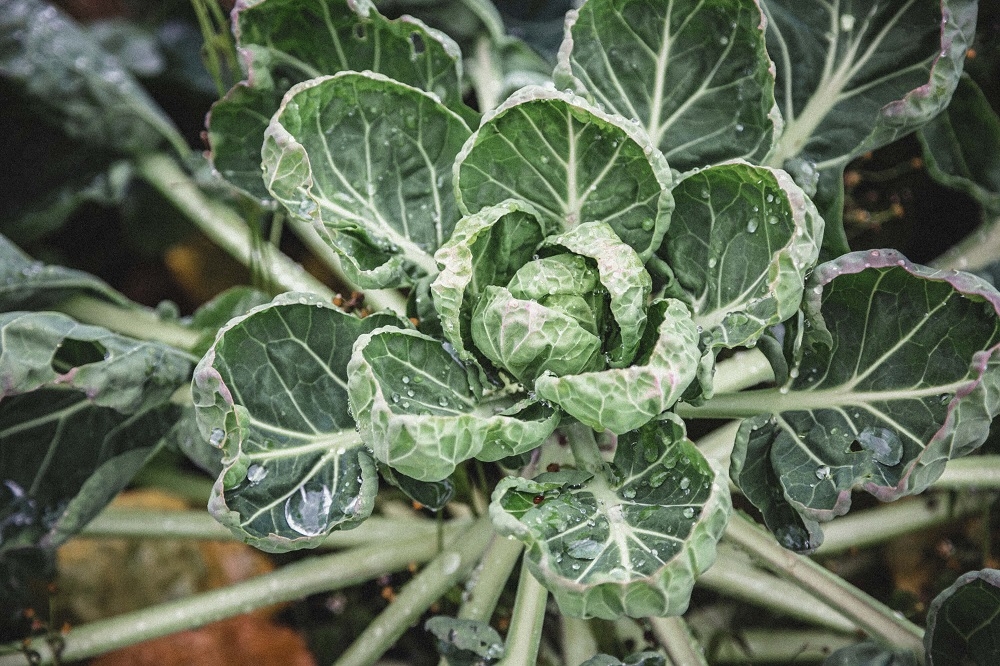
In the kitchen
How to store Brussels sprouts tops
Open-hearted and loosely packed, these leaves have a shorter shelf life than the more tightly formed Brussels sprout. Store in the fridge and eat sooner rather than later - they should keep well for 3-4 days.
Prep & Cooking tips
You’ll only need to strip the leaves away from the larger stalks. The smaller central leaves can be sliced and cooked, stalks and all. The best way to chop the leaves is to lay them on top of one another and roll them into a tight cigar shape, then shred them, widthways, thickly or thinly depending on the daintiness of your dish. Wash them well before using. Any cluster of baby sprouts that cling to the stalk are a chef’s perk.
Use in any recipe that calls for cabbage, kale or sprouts. They are best finely shredded and then gently fried in a little butter or oil. It will only take a matter of mins for them to wilt and become tender. They boil or steam in next to no time or can be stirred into any number of soups, stews and curries for the last few minutes. Try them in a hearty bowl of Portuguese caldo verde in place of cabbage, wilted and stirred through mashed potato for a simple colcannon, or fried with bacon and chestnuts instead of regular sprouts.
Easy ideas
1. Simple
Things needn’t always be complicated. These greens are often at their best simply steamed, boiled or lightly wilted in a pan. A few mins is all you need; cook it for too long and, as with most brassicas, you’ll start to release more pungent flavours. Season with a little salt and pepper. If you feel the need then add a little butter or olive oil and maybe a restrained squeeze of lemon to finish.
2. Simple sides
As a side dish it can be a real cultural chameleon. Fry gently with a little desiccated coconut and black onion seed to set alongside a curry. Sauté in a hot wok with ginger, chilli and soy for all things Asian. Some crispy bacon and fragrant caraway invite a union with something dark and winey. A swirl of wholegrain mustard for a spontaneous Sunday side.
3. The finishing touch
Very finely shredded, these greens make a fresh and healthy finish to a robust soup or stew. A minestrone or ribollita, heavy with tomatoes and beans, would be ideal. The Portuguese caldo verde is simply stock, potatoes, chorizo and handfuls of sliced greens to finish. Even a deep savoury bowl of miso will be enriched with a tangle of noodle-thin greens. 4 mins should be fine on a gentle simmer, serve immediately.
Goes well with
Acidic flavours (lemon, vinegar, white wine) Alliums (Garlic, leek, onions)
Asian flavours (miso, soy etc.)
Dairy (butter, cream, Parmesan)
Herbs (bay, thyme, sage, rosemary)
Spices (Pepper, carraway, chilli, juniper, nutmeg, nigella seeds, mustard seeds)
Nuts and seeds (chestnuts, hazelnuts & sesame in particular)
Pork, bacon, chorizo
Shellfish & smoked fish Lentils
Brussels sprouts tops recipes
-

Venison Cutlet and Root Veg Boulangère with Shredded Sprout Tops
Serves: 2 Total time: 1h 10 min
-

Roasted brussels with sage and chestnut butter
Serves: 6 Total time: 40 min
-

Sprouts, red onion and blue cheese gratin
Serves: 4 Total time: 1h
-

Brussels sprout, chorizo and potato hash
Serves: 4 Total time: 55 min
-

Sprout top and chorizo Caldo Verde
Serves: 4 Total time: 50 min
-

Shredded Brussels sprouts salad
Serves: 4 Total time: 20 min
In the field
-

Meet the grower: 'Organic Dan' Gielty , Ormskirk, Lancashire
Dan Gielty (known as ‘Organic Dan’) farms in West Lancashire. His organic Brussels sprouts are a much anticipated highlight of our winter veg boxes.





